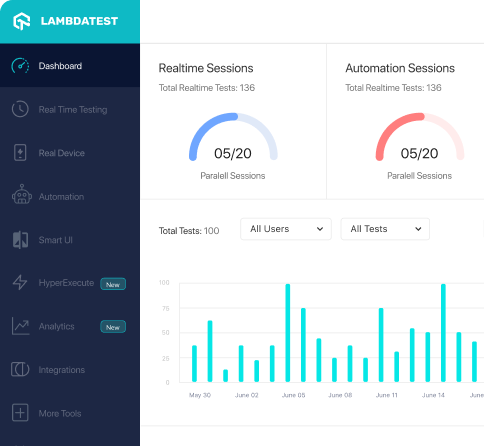How to use ByteArrayAssert_asBase64Encoded_Test class of org.assertj.core.api.bytearray package
Best Assertj code snippet using org.assertj.core.api.bytearray.ByteArrayAssert_asBase64Encoded_Test
...21import org.junit.jupiter.api.Test;22/**23 * @author Stefano Cordio24 */25class ByteArrayAssert_asBase64Encoded_Test extends ByteArrayAssertBaseTest implements NavigationMethodBaseTest<ByteArrayAssert> {26 @Override27 protected ByteArrayAssert invoke_api_method() {28 assertions.asBase64Encoded();29 return null;30 }31 @Override32 protected void verify_internal_effects() {33 verify(objects).assertNotNull(getInfo(assertions), getActual(assertions));34 }35 @Override36 public void should_return_this() {37 // Test disabled as the assertion does not return this.38 }39 @Override...ByteArrayAssert_asBase64Encoded_Test
Using AI Code Generation
1package org.assertj.core.api.bytearray;2import static org.assertj.core.api.Assertions.assertThat;3import static org.assertj.core.api.Assertions.assertThatExceptionOfType;4import static org.assertj.core.api.Assertions.catchThrowable;5import static org.mockito.Mockito.verify;6import org.assertj.core.api.ByteArrayAssert;7import org.assertj.core.api.ByteArrayAssertBaseTest;8import org.junit.jupiter.api.Test;9class ByteArrayAssert_asBase64Encoded_Test extends ByteArrayAssertBaseTest {10 void should_allow_assertions_on_base64_decoded_byte_array() {11 byte[] bytes = "some bytes".getBytes();12 Throwable thrown = catchThrowable(() -> assertThat(bytes).asBase64()13 .isEqualTo("c29tZSBieXRlcw=="));14 assertThat(thrown).isNull();15 }16 void should_fail_when_asserting_on_base64_decoded_byte_array_and_base64_is_not_valid() {17 byte[] bytes = "some bytes".getBytes();18 Throwable thrown = catchThrowable(() -> assertThat(bytes).asBase64()19 .isEqualTo("some invalid base64"));20 assertThat(thrown).isInstanceOf(AssertionError.class)21 .hasMessageContaining("Expecting byte array to be equal to:")22 .hasMessageContaining("but was not.");23 }24 void should_fail_when_asserting_on_base64_decoded_byte_array_and_decoded_value_is_not_equal() {25 byte[] bytes = "some bytes".getBytes();26 Throwable thrown = catchThrowable(() -> assertThat(bytes).asBase64()27 .isEqualTo("c29tZSBieXRlcw=="));28 assertThat(thrown).isInstanceOf(AssertionError.class)29 .hasMessageContaining("Expecting byte array to be equal to:")30 .hasMessageContaining("but was not.");31 }32 void should_fail_when_asserting_on_base64_decoded_byte_array_and_decoded_value_is_not_equal_to_the_expected_one() {33 byte[] bytes = "some bytes".getBytes();34 Throwable thrown = catchThrowable(() -> assertThat(bytes).asBase64()35 .isEqualTo("c29tZSBieXRlcw=="));36 assertThat(thrown).isInstanceOf(AssertionError.class)ByteArrayAssert_asBase64Encoded_Test
Using AI Code Generation
1import static org.assertj.core.api.Assertions.assertThat;2import java.util.Base64;3import org.junit.Test;4public class ByteArrayAssert_asBase64Encoded_Test {5 public void should_encode_byte_array() {6 byte[] byteArray = "AssertJ".getBytes();7 assertThat(byteArray).asBase64().isEqualTo(Base64.getEncoder().encodeToString(byteArray));8 }9}ByteArrayAssert_asBase64Encoded_Test
Using AI Code Generation
1import org.assertj.core.api.ByteArrayAssert;2import org.assertj.core.api.ByteArrayAssertBaseTest;3import static org.mockito.Mockito.verify;4public class ByteArrayAssert_asBase64Encoded_Test extends ByteArrayAssertBaseTest {5 protected ByteArrayAssert invoke_api_method() {6 return assertions.asBase64();7 }8 protected void verify_internal_effects() {9 verify(bytes).asBase64();10 }11}12public class ByteArrayAssertBaseTest extends BaseTestTemplate<ByteArrayAssert, byte[]> {13 protected Class<?> getAssertClass() {14 return ByteArrayAssert.class;15 }16 protected Class<?> getAssertBaseClass() {17 return AbstractByteArrayAssert.class;18 }19 protected Class<?>[] getAssertAdditionalInterfaces() {20 return new Class<?>[] { IterableAssert.class, ObjectEnumerableAssert.class };21 }22}23public abstract class BaseTestTemplate<ASSERT extends Assert<?, ?>, ACTUAL> {24 protected ASSERT assertions;25 protected ACTUAL actual;26 public void setup() {27 actual = createActual();28 assertions = createAssertions();29 }30 protected abstract Class<?> getAssertClass();31 protected abstract Class<?> getAssertBaseClass();32 protected abstract Class<?>[] getAssertAdditionalInterfaces();33 public void should_have_appropriate_assert_base_class() {34 assertThat(assertions).isInstanceOf(getAssertBaseClass());35 }36 public void should_have_appropriate_assert_class() {37 assertThat(assertions).isExactlyInstanceOf(getAssertClass());38 }39 public void should_have_appropriate_assert_additional_interfaces() {40 assertThat(assertions).isInstanceOfAny(getAssertAdditionalInterfaces());41 }42 protected abstract ASSERT createAssertions();43 protected abstract ACTUAL createActual();44}ByteArrayAssert_asBase64Encoded_Test
Using AI Code Generation
1[org.assertj.core.api.bytearray.ByteArrayAssert_asBase64Encoded_Test.java][]: package org.assertj.core.api.bytearray;2[org.assertj.core.api.bytearray.ByteArrayAssert_asBase64Encoded_Test.java][]: import static org.mockito.Mockito.verify;3[org.assertj.core.api.bytearray.ByteArrayAssert_asBase64Encoded_Test.java][]: import org.assertj.core.api.ByteArrayAssert;4[org.assertj.core.api.bytearray.ByteArrayAssert_asBase64Encoded_Test.java][]: import org.assertj.core.api.ByteArrayAssertBaseTest;5[org.assertj.core.api.bytearray.ByteArrayAssert_asBase64Encoded_Test.java][]: public class ByteArrayAssert_asBase64Encoded_Test extends ByteArrayAssertBaseTest {6[org.assertj.core.api.bytearray.ByteArrayAssert_asBase64Encoded_Test.java][]: protected ByteArrayAssert invoke_api_method() {7[org.assertj.core.api.bytearray.ByteArrayAssert_asBase64Encoded_Test.java][]: return assertions.asBase64();8[org.assertj.core.api.bytearray.ByteArrayAssert_asBase64Encoded_Test.java][]: }9[org.assertj.core.api.bytearray.ByteArrayAssert_asBase64Encoded_Test.java][]: protected void verify_internal_effects() {10[org.assertj.core.api.bytearray.ByteArrayAssert_asBase64Encoded_Test.java][]: verify(strings).assertIsBase64Compatible(getInfo(assertions), getActual(assertions));Blogs
Check out the latest blogs from LambdaTest on this topic:
Have you ever struggled with handling hidden elements while automating a web or mobile application? I was recently automating an eCommerce application. I struggled with handling hidden elements on the web page.
Did you know that according to Statista, the number of smartphone users will reach 18.22 billion by 2025? Let’s face it, digital transformation is skyrocketing and will continue to do so. This swamps the mobile app development market with various options and gives rise to the need for the best mobile app testing tools
The best agile teams are built from people who work together as one unit, where each team member has both the technical and the personal skills to allow the team to become self-organized, cross-functional, and self-motivated. These are all big words that I hear in almost every agile project. Still, the criteria to make a fantastic agile team are practically impossible to achieve without one major factor: motivation towards a common goal.
Joseph, who has been working as a Quality Engineer, was assigned to perform web automation for the company’s website.
Automation Testing Tutorials
Learn to execute automation testing from scratch with LambdaTest Learning Hub. Right from setting up the prerequisites to run your first automation test, to following best practices and diving deeper into advanced test scenarios. LambdaTest Learning Hubs compile a list of step-by-step guides to help you be proficient with different test automation frameworks i.e. Selenium, Cypress, TestNG etc.
LambdaTest Learning Hubs:
- JUnit Tutorial
- TestNG Tutorial
- Webdriver Tutorial
- WebDriverIO Tutorial
- Protractor Tutorial
- Selenium 4 Tutorial
- Jenkins Tutorial
- NUnit Tutorial
- Jest Tutorial
- Playwright Tutorial
- Cypress Tutorial
- PyTest Tutorial
YouTube
You could also refer to video tutorials over LambdaTest YouTube channel to get step by step demonstration from industry experts.
Most used methods in ByteArrayAssert_asBase64Encoded_Test
Try LambdaTest Now !!
Get 100 minutes of automation test minutes FREE!!




